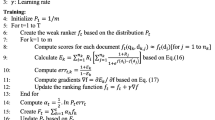Abstract
We propose an efficient algorithm that directly optimizes a ranking performance measure, with a focus on class average precision (AP). Instead of using pair-wise ranking approximation in defining a loss function by conventional approaches, we use an efficient gradient-based approach that approximates a discrete ranking performance measure. In particular, AP is considered as a staircase function with respect to each individual sample score after rank ordering is applied to all samples. Then, a combination of sigmoid functions is applied to approximate the staircase AP function as a continuous and differntiable function of the model parameters used to compute the sample scores. Compared to the use of pair-wise rankings, the proposed approach substantially reduces the computational complexity to a manageable level when estimating model parameters with a gradient descent algorithm. In terms of explicitly optimizing a target performance metric, the proposed algorithm can be considered as an extension of maximal figure-of-merit (MFoM) learning to optimization of a ranking performance measure. Our experiments on two challenging image-retrieval datasets showcased the usefulness of the proposed framework in both improving AP and achieving learning efficiency.








Similar content being viewed by others
References
Toderici, G., Aradhye, H., Pasca, M., Sbaiz, L., Yagnik, J. (2010). Finding meaning on youtube: tag recommendation and category discovery. In CVPR.
Jiang, Y.-G., Ye, G., Chang, S.-F., Ellis, D., Loui, A.C. (2011). Consumer video understanding: a benchmark database and an evaluation of human and machine performance. In ACM ICMR.
Smeaton, A.F., Over, P., Kraaij, W. (2006). Evaluation campaigns and trecvid. In ACM MIR.
Wang, Z., Zhao, M., Song, Y., Kumar, S., Li, B. (2010). YouTubeCat: learning to categorize wild web videos. In CVPR.
Over, P., Awad, G., Fiscus, J., Michel, M., Smeaton, A.F., Kraaij, W. (2009). TRECVID 2009-goals, tasks, data, evaluation mechanisms and metrics. In Proceedings of TRECVID workshop.
Gao, S., Wu, W., Lee, C.-H., Chua, T.-S. (2004). A MFoM learning to robust multiclass multi-label text categorization. In Proceedings of ICML.
Katagiri, S., Juang, B.-H., Lee, C.-H. (1998). Pattern recognition using a family of design algorithm based upon the generalized probabilistic descent method. In Proceedings of the IEEE (pp. 2345–2373).
Joachims, T. (2002). Optimizing search engines using clickthrough data. In Proceedings of KDD.
Freund, Y., Iyer, R., Schapire, R.E., Singer, Y. (2003). An efficient boosting algorithm for combining preferences. Journal of Machine Learning Research, 4, 933–969.
Burges, C., Shaked, T., Renshaw, E., Lazier, A., Deeds, M., Hamilton, N., Hullender, G. (2005). Learning to rank using gradient descent. In Proceedings of ICML.
Gao, S., Lee, C.-H., Lim, J.H. (2006). An ensemble classifier learning approach to ROC optimization. In Proceedings of ICPR.
Gao, S., & Sun, Q. (2007). Improving semantic concept detection through optimizing ranking function. IEEE Transactions on Multimedia, 9, 1430–1442.
Fawcett, T. (2006). Introduction to roc analysis. Pattern Recognition Letters, 27, 861–874.
McFee, B. (2010). Metric learning to rank. In Proceedings of ICML.
Cao, Z., Qin, T., Liu, T.-Y., Tsai, M.-F., Li, H. (2007). Learning to rank: from pairwise approach to listwise approach. In Proceedings of ICML.
Xia, F., Liu, T.-Y., Wang, J., Zhang, W., Li, H. (2008). Listwise approach to learning to rank—theory and algorithm. In Proceedings of ICML.
Ma, C., & Lee, C.-H. (2008). An efficient gradient computation approach to discriminative fusion optimization in semantic concept detection. In Proceedings of ICPR.
Wang, L., Lin, J., Metzler, D. (2010). Learning to efficiently rank. In Proceedings of ACM SIGIR (pp. 138–145).
Cambazoglu, B.B., Zaragoza, H., Chapelle, O., Chen, J., Liao, C., Zheng, Z., Degenhardt, J. (2010). Early exit optimizations for additive machine learned ranking systems. In Proceedings of ACM WSDM.
Valizadegan, H., Jin, R., Zhang, R., Mao, J. (2009). Learning to rank by optimizing NDCG measure. In Proceedings of NIPS.
Gao, S., Wu, W., Lee, C.-H., Chua, T.-S. (2003). A maximal figure-of-merit approach to text categorization. In Proceedings of ACM SIGIR.
Kim, I., Oh, S., Byun, B., Perera, A.G.A., Lee, C.-H. (2012). Explicit performance metric optimization for fusion-based video retrieval. In Proceedings of ECCV workshops.
Yan, L., Dodier, R., Mozer, M.C., Wolniewicz, R. (2003). Optimizing classifier performance via an approximation to the Wilcoxon-Mann-Whitney statistic. In Proceedings of ICML.
Watanabe, H., Tokuno, J., Ohashi, T., Katagiri, S., Ohsaki, M. (2011). Minimum classification error training with automatic setting of loss smoothness. In MLSP.
Sun, W., & Yuan, Y.-X. (2006). Optimization theory and methods: nonlinear programming (pp. 102–117). New York: Springer.
Kennedy, L., & Hauptmann, A. (2006). LSCOM lexicon definition and annotation version 1.0. In Proceedings of DTO challenge workshop on large scale concept ontology for multimedia.
Over, P. (2006). Guidelines for the TRECVID 2006 evaluation. In http://www-nlpir.nist.gov/projects/tv2006. Accessed 15 March 2012.
Gao, S., Wang, D.-H., Lee, C.-H. (2006). Automatic image annotation through multi-topic text categorization. In Proceedings of ICASSP.
Bellegarda, J.R. Exploiting latent semantic information in statistical language modeling (pp. 1279–1296).
Swain, M.J., & Ballard, D.H. (1991). Color indexing. International Journal of Computer Vision, 7, 11–32.
Zhang, D., Chen, X., Lee, W.S. (2005). Text classification with kernels on the multinomial manifold. In Proceedings of Special Interest Group on Information Retrieval.
Author information
Authors and Affiliations
Corresponding author
Rights and permissions
About this article
Cite this article
Kim, I., Lee, CH. An Efficient Gradient-based Approach to Optimizing Average Precision Through Maximal Figure-of-Merit Learning. J Sign Process Syst 74, 285–295 (2014). https://doi.org/10.1007/s11265-013-0748-0
Received:
Revised:
Accepted:
Published:
Issue Date:
DOI: https://doi.org/10.1007/s11265-013-0748-0




